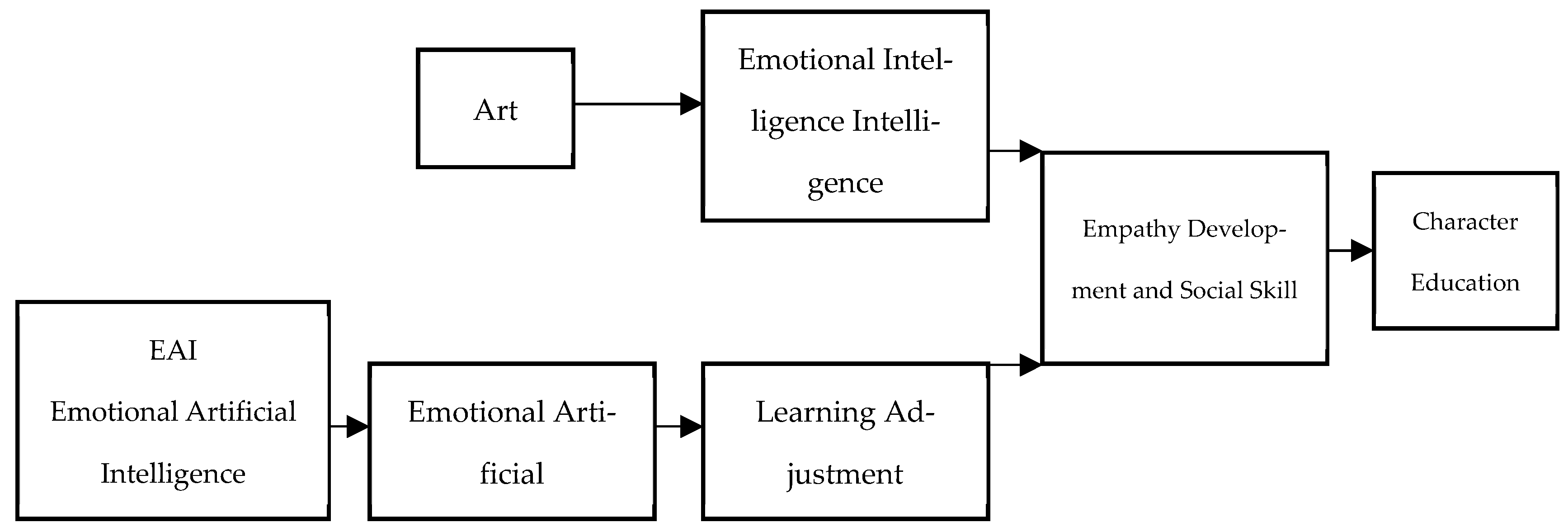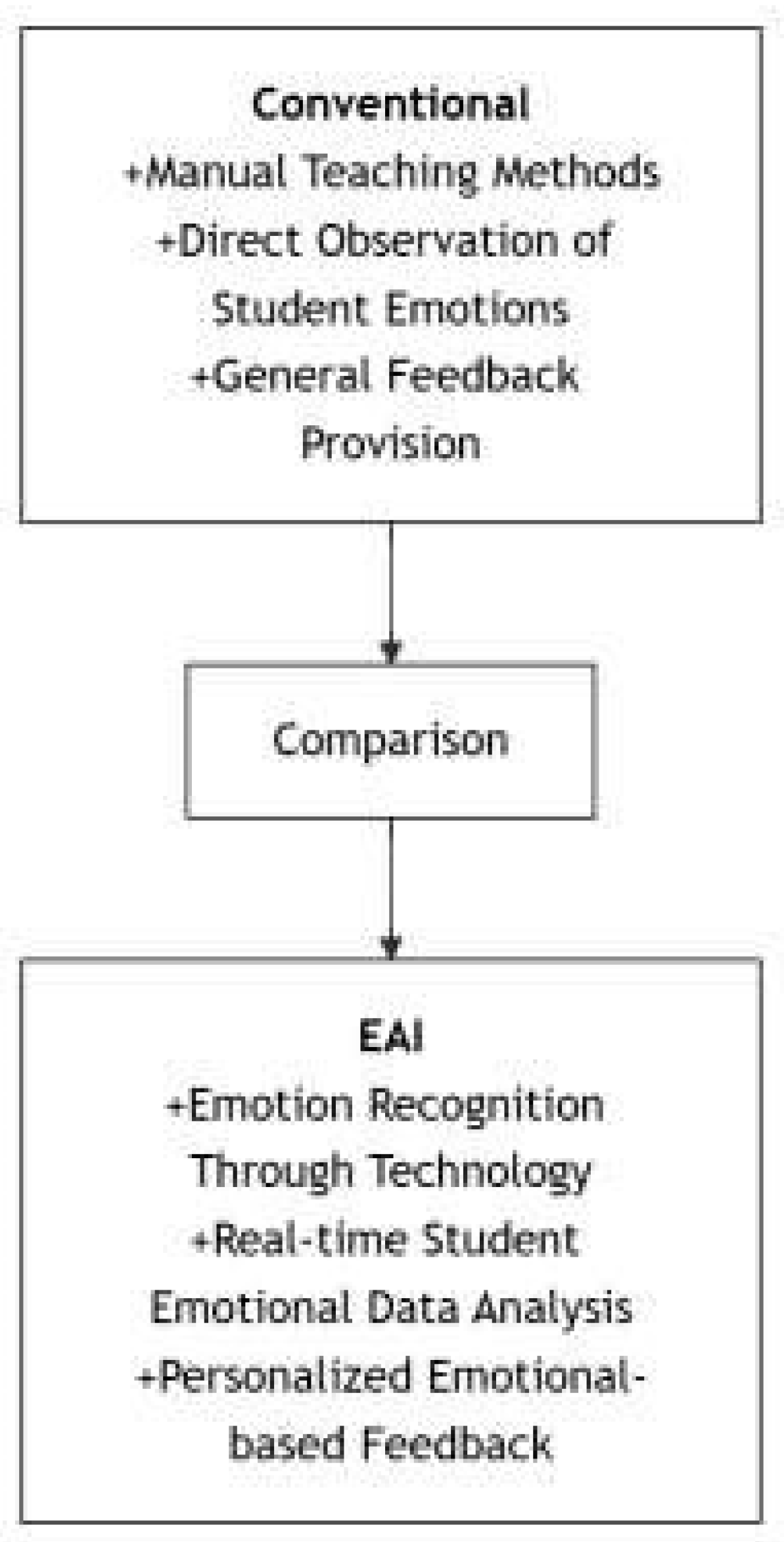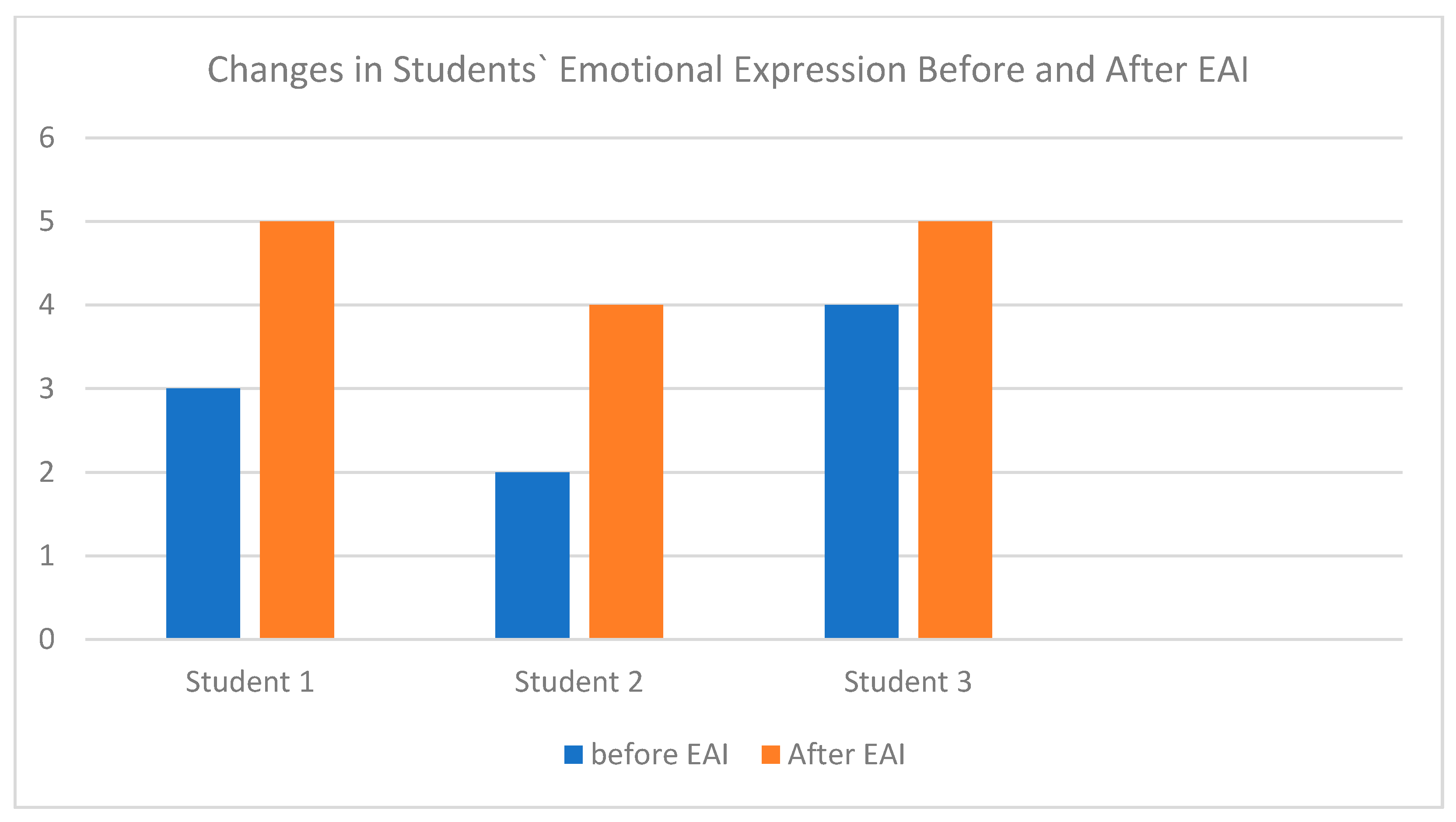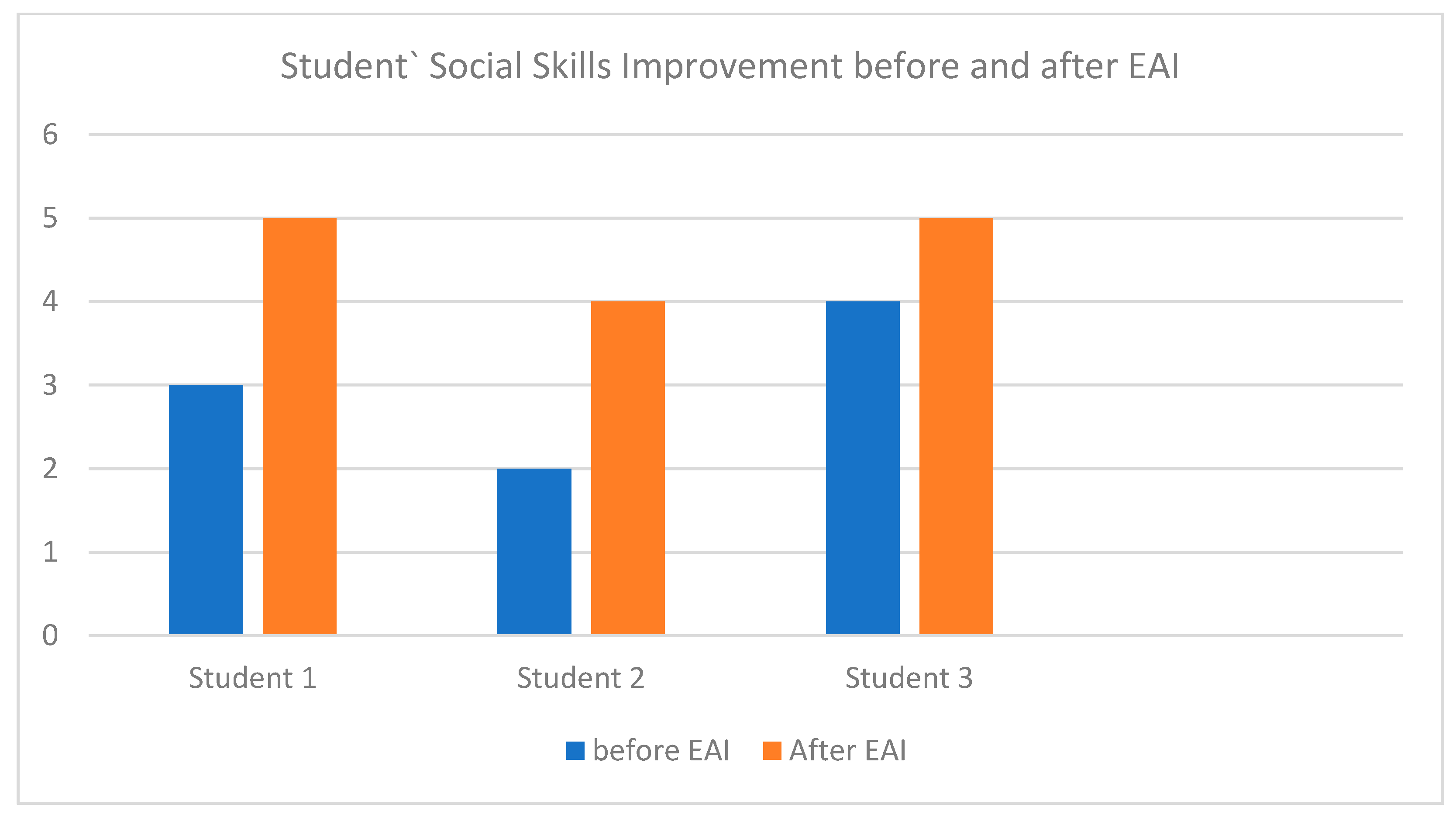Utilization of Emotional Artificial Intelligence (EAI) in Art Learning to Improve Character Education of Elementary School Students †
Abstract
1. Introduction
2. Literature Review
3. Research Methods
- Teachers: Six teachers directly involved in the integration and use of EAI in art classrooms. These teachers were selected for their hands-on experience and ability to provide insights into the challenges and benefits of EAI in the learning environment.
- Students: A total of 30 students participated in the art learning program with EAI integration. Among these, 20 students were directly involved in the use of EAI to assess its impact on their emotional intelligence, social skills, and emotional expression. Students were randomly selected from the classes that utilized EAI in their learning.
- Parents: Ten parents were included to provide their perspectives on how the integration of EAI affected their child’s social–emotional development. Parents were selected based on their child’s involvement in the EAI program.
- Interviews: Semi-structured interviews were conducted with six teachers, ten parents, and ten students. The interviews aimed to capture participants’ perceptions and experiences regarding the use of EAI in art learning and its effects on students’ character development. The interviews were open-ended to allow participants to share detailed insights.
- Observations: Observations were carried out during 10 art learning sessions where EAI was implemented. These observations focused on how students interacted with EAI and how their emotional responses evolved during and after these sessions. A total of 20 students were observed for their engagement with the learning materials and their emotional responses.
- Artwork Analysis: Students’ artwork created before and after the introduction of EAI was analyzed. The goal was to evaluate changes in the emotional expression, creativity, and social interaction within the students’ artwork. This analysis helped assess the depth of emotional expression and how their artistic outputs evolved.
4. Results and Discussion
Changes in Emotional Expression
5. Conclusions
Author Contributions
Funding
Institutional Review Board Statement
Informed Consent Statement
Data Availability Statement
Conflicts of Interest
References
- Ahmad, S.; Rahmat, M.; Mubarik, M.; Alam, M.; Hyder, S. Artificial Intelligence and Its Role in Education. Sustainability 2021, 13, 12902. [Google Scholar] [CrossRef]
- Amalianita, B.; Eliza, R.; Nurnilamsari, N.; Putra, R.P.; Rahmayanty, D.; Kusnaini, U.N. The Role of Adolescent Character Education in Schools and Implications for Guidance and Counseling Services (Peran Pendidikan Karakter Remaja di Sekolah serta Implikasi Terhadap Layanan Bimbingan Dan Konseling). J. Ris. Tindakan Indones. 2023, 8, 276–283. (In Indonesian) [Google Scholar]
- Armini, N.K. Evaluation of student development assessment methods and character education in the independent curriculum in elementary schools (Evaluasi metode penilaian perkembangan siswa dan pendidikan karakter dalam kurikulum merdeka pada sekolah dasar). Metta J. Ilmu Multidisiplin 2024, 4, 98–112. (In Indonesian) [Google Scholar] [CrossRef]
- Insani, G.N.; Dewi, D.A.; Furnamasari, Y.F. Integration of character education in civic education learning to develop the character of elementary school students (Integrasi pendidikan karakter dalam pembelajaran pendidikan kewarganegaraan untuk mengembangkan karakter siswa sekolah dasar). J. Pendidik. Tambusai 2021, 5, 8153–8160. (In Indonesian) [Google Scholar]
- Chaharbashloo, H.; Gholami, K.; Aliasgari, M.; Talebzadeh, H.; Mousapour, N. Analytical reflection on teachers’ practical knowledge: A case study of exemplary teachers in an educational reform context. Teach. Teach. Educ. 2020, 87, 102931. [Google Scholar] [CrossRef]
- Chen, S.; Lin, P.; Chien, W. Children’s Digital Art Ability Training System Based on AI-Assisted Learning: A Case Study of Drawing Color Perception. Front. Psychol. 2022, 13, 102931. [Google Scholar] [CrossRef]
- Cong, S. A Study of Teaching Strategies Optimized with the Integration of Artificial Intelligence Technologies. Appl. Math. Nonlinear Sci. 2024, 9, 1195. [Google Scholar] [CrossRef]
- Dai, Y.; Liu, A.; Qin, J.; Guo, Y.; Jong, M.; Chai, C.; Lin, Z. Collaborative construction of artificial intelligence curriculum in primary schools. J. Eng. Educ. 2022, 112, 23–42. [Google Scholar] [CrossRef]
- Engelsrud, G.; Rugseth, G.; Nordtug, B. Taking time for new ideas: Learning qualitative research methods in higher sports education. Sport Educ. Soc. 2021, 28, 239–252. [Google Scholar] [CrossRef]
- Ezquerra, Á.; Agen, F.; Rodríguez-Arteche, I.; Ezquerra-Romano, I. Integrating Artificial Intelligence into Research on Emotions and Behaviors in Science Education. Eurasia J. Math. Sci. Technol. Educ. 2022, 18, 11927. [Google Scholar] [CrossRef]
- Kahila, J.; Vartiainen, H.; Tedre, M.; Arkko, E.; Lin, A.; Pope, N.; Jormanainen, I.; Valtonen, T. Pedagogical framework for cultivating children’s data agency and creative abilities in the age of AI. Inform. Educ. 2024, 23, 15. [Google Scholar] [CrossRef]
- Kamila, A. The Importance of Islamic Religious Education and Moral Education in Building the Character of Elementary School Children (Pentingnya Pendidikan Agama Islam dan Pendidikan Moral dalam Membina Karakter Anak Sekolah Dasar). Al-Furqan J. Agama Sos. Dan Budaya 2023, 2, 321–338. (In Indonesian) [Google Scholar]
- Karya, D.; Kusumastuti, S.Y.; Kabul, E.R.; Mantong, S.H.J.; Sjukun, S.T.; SM, M. Qualitative Research Methodology (Metodologi Penelitian Kualitatif); Takaza Innovatix Labs: Kota Padang, Indonesia, 2024. (In Indonesian) [Google Scholar]
- Khoirroni, I.A.; Patinasarani, R.; Hermayanti, N.I.; Santoso, G. Character Education: Elementary School Children in the Digital Age (Pendidikan Karakter: Tingkat Anak Sekolah Dasar di Era Digital). J. Pendidik. Transform. 2023, 2, 269–279. (In Indonesian) [Google Scholar]
- Lee, H.; Lee, M. Visual art education and social-emotional learning of students in rural Kenya. Int. J. Educ. Res. 2021, 108, 101781. [Google Scholar] [CrossRef]
- Lundberg, A.; De Leeuw, R.; Aliani, R. Using Q methodology: Sorting out subjectivity in educational research. Educ. Res. Rev. 2020, 31, 100361. [Google Scholar] [CrossRef]
- Mariyono, D. Mastering Qualitative Research Methods, Applied Analysis, and Future Directions (Menguasai Penelitian Kualitatif Metode, Analisis Terapan, dan Arah Masa Depan); Cipta Media Nusantara: Surabaya, Indonesia, 2024. (In Indonesian) [Google Scholar]
- Ortju, L.; Kankkunen, P.; Haaranen, A.; Karlsson, L. Researcher-initiated role play, stimulated recall interview, storycrafting, painting and drawing as research methods to reach children’s perspectives in health sciences. J. Adv. Nurs. 2023, 80, 2988–3001. [Google Scholar] [CrossRef] [PubMed]
- Seo, K.; Tang, J.; Roll, I.; Fels, S.; Yoon, D. The impact of artificial intelligence on learner–instructor interaction in online learning. Int. J. Educ. Technol. High. Educ. 2021, 18, 54. [Google Scholar] [CrossRef]
- Vistorte, A.; Deroncele-Acosta, A.; Ayala, J.; Barrasa, A.; López-Granero, C.; Martí-González, M. Integrating artificial intelligence to assess emotions in learning environments: A systematic literature review. Front. Psychol. 2024, 15, 1387089. [Google Scholar] [CrossRef]
- Chernobrovkin, V.; Tupikina, D.; Karlova, Y.; Yakovleva, E. Use of works of art in the development of emotional intelligence preschool children. Perspekt. Nauk. I Obraz. 2021, 4, 327–342. (In Russian) [Google Scholar] [CrossRef]
- Rizzuto, T.; Cordeiro, K.; Roda, A. The lost art: Teachers’ perceptions of the connections between the arts and social-emotional learning. Arts Educ. Policy Rev. 2022, 125, 150–162. [Google Scholar] [CrossRef]
- Freedman, K.; Cornwall, J.; Schulte, C.; Carpenter, B.; Castro, J. Mapping Research with a Systematic Review: The Example of Social and Emotional Learning in Art Education. Stud. Art Educ. 2022, 63, 296–312. [Google Scholar] [CrossRef]
- Rong, Q.; Lian, Q.; Tang, T. Research on the Influence of AI and VR Technology for Students’ Concentration and Creativity. Front. Psychol. 2022, 13, 767689. [Google Scholar] [CrossRef] [PubMed]
- McStay, A. Emotional AI and EdTech: Serving the public good? Learn. Media Technol. 2020, 45, 270–283. [Google Scholar] [CrossRef]
- Zhoc, K.; King, R.; Chung, T.; Chen, J. Emotionally intelligent students are more engaged and successful: Examining the role of emotional intelligence in higher education. Eur. J. Psychol. Educ. 2020, 35, 839–863. [Google Scholar] [CrossRef]
- Chiu, M.-C.; Hwang, G.-J.; Hsia, L.-H.; Shyu, F.-M. Artificial intelligence-supported art education: A deep learning-based system for promoting university students’ artwork appreciation and painting outcomes. Interact. Learn. Environ. 2022, 32, 824–842. [Google Scholar] [CrossRef]
- Hunt, R. Student ‘Characters’ in Qualitative Research. Chang. Engl. 2022, 29, 335–350. [Google Scholar] [CrossRef]
- Kamalov, F.; Calonge, D.; Gurrib, I. New Era of Artificial Intelligence in Education: Towards a Sustainable Multifaceted Revolution. Sustainability 2023, 15, 12451. [Google Scholar] [CrossRef]





| Students | Before EAI (Expression) | After EAI (Expression) | Change (Scale) |
|---|---|---|---|
| Student 1 | Standard expression | More expressive and emotional | 3/5 |
| Student 2 | Tends to be flat | More layered and complex | 4/5 |
| Student 3 | Attractive but simple | Shows a variety of emotions | 4/5 |
| Students | Before EAI (Engagement) | After EAI (Engagement) | Changes |
|---|---|---|---|
| Student 1 | 3/5 | 5/5 | 2/5 |
| Student 2 | 2/5 | 4/5 | 2/5 |
| Student 3 | 3/5 | 5/5 | 2/5 |
| Students | Before EAI (Engagement) | After EAI (Engagement) | Changes |
|---|---|---|---|
| Student 1 | 3/5 | 5/5 | 2/5 |
| Student 2 | 2/5 | 4/5 | 2/5 |
| Student 3 | 3/5 | 5/5 | 2/5 |
Disclaimer/Publisher’s Note: The statements, opinions and data contained in all publications are solely those of the individual author(s) and contributor(s) and not of MDPI and/or the editor(s). MDPI and/or the editor(s) disclaim responsibility for any injury to people or property resulting from any ideas, methods, instructions or products referred to in the content. |
© 2025 by the authors. Licensee MDPI, Basel, Switzerland. This article is an open access article distributed under the terms and conditions of the Creative Commons Attribution (CC BY) license (https://creativecommons.org/licenses/by/4.0/).
Share and Cite
Aprilia, P.; Ijudin, M.F.; Manda, A.; Adela, D. Utilization of Emotional Artificial Intelligence (EAI) in Art Learning to Improve Character Education of Elementary School Students. Eng. Proc. 2025, 107, 135. https://doi.org/10.3390/engproc2025107135
Aprilia P, Ijudin MF, Manda A, Adela D. Utilization of Emotional Artificial Intelligence (EAI) in Art Learning to Improve Character Education of Elementary School Students. Engineering Proceedings. 2025; 107(1):135. https://doi.org/10.3390/engproc2025107135
Chicago/Turabian StyleAprilia, Putri, Muhammad Fariz Ijudin, Arla Manda, and Dhea Adela. 2025. "Utilization of Emotional Artificial Intelligence (EAI) in Art Learning to Improve Character Education of Elementary School Students" Engineering Proceedings 107, no. 1: 135. https://doi.org/10.3390/engproc2025107135
APA StyleAprilia, P., Ijudin, M. F., Manda, A., & Adela, D. (2025). Utilization of Emotional Artificial Intelligence (EAI) in Art Learning to Improve Character Education of Elementary School Students. Engineering Proceedings, 107(1), 135. https://doi.org/10.3390/engproc2025107135





